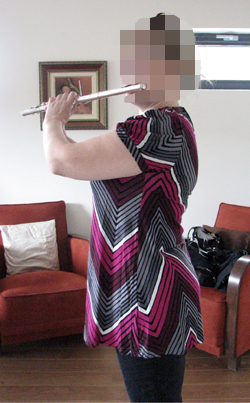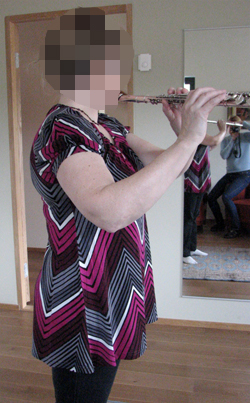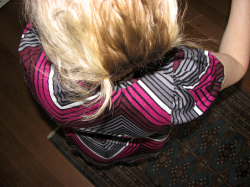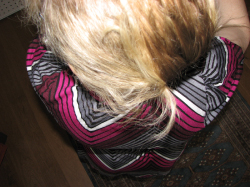Flute - harjoittelu
Flute
Read the Ergonomics Overview first.
The body's centre position is the basic position to which the musician always returns. In the centre position, the spine maintains its natural curves. Spinal curves vary between individuals; in the centre position, the backs and hips of different people may look different.
In order to find a good posture, flutists should first examine the position of their pelvis. The pelvis should be in the centre position to allow the muscles that maintain the position of the pelvis and the lumbar spine to work freely. In this position, breathing is also easy. The ischia should point directly downwards towards the seat. Next, the musician's thoracic spine is examined. The thoracic spine should be in the centre position so that the back muscles are engaged but not tense; the breastbone stays in a vertical position and does not tilt forward. Maintaining the centre position in the pelvis, lumbar spine and the thoracic spine facilitates natural movement in the ribs and the rib cage - a key factor for the right breathing technique of wind instruments.
In order to find the correct posture, flutists should first examine the position of their pelvis. The pelvis should be in the centre position so that the muscles supporting the pelvis and the spine can work freely (the ischia point directly downwards in a seated position).
The thoracic spine should also be in the centre position to ensure the mobility of the rib cage and correct breathing. When the thoracic spine is in the centre position, the breastbone is in a vertical position and the back extensors are engaged but not tense. During inhaling, the rib cage can expand freely in all directions, including sideways and backwards. The rib cage/thoracic spine and the pelvis should be aligned when viewed from the side. If the thoracic spine tilts backwards in relation to the pelvis, rib cage and diaphragm movement is affected and the musician's breathing suffers.
The centre position of the head and neck can be found by first moving the head back and forward, then leaving it in the centre position where there is free movement between the skull and the cervical spine. The position of the neck, head and jaw joints has an effect on the control of neck muscles, jaw muscles and throat muscles. The head and the neck should be in the centre position to facilitate good support for the head from the deep neck muscles. These support muscles enable the superficial muscles to relax. If the head pushes forward (often as a result of a faulty position in the lower spine), it increases tension in the neck muscles, jaw muscles and superficial neck muscles, which can affect the playing technique.
A correct position of the thoracic spine and the rib cage enables optimal muscular support for the shoulder blades. The shoulder blades should be in a vertical position against the ribs, encouraging a natural position of the shoulders. If the shoulder blade tilts forward and/or wings off of the ribs, the shoulder blade support muscles cannot function correctly, affecting the mobility of the rib cage.
|
The pelvis and spine are in the centre position; the head is also in the correct position. |
The pelvis tilts in posterior (forward); the thoracic spine curves, the torso twists to the right, head pushes forward. |
The three-dimensional movement of the shoulder blade can be difficult to perceive, and the musician may require professional help during shoulder blade exercises.
During playing, flutists are prone to twisting to the right and tilting backward. However, this turning motion should be avoided, with the exception of the cervical spine. The torso should be straight while the cervical spine is rotated to the left. When the cervical spine and the thoracic spine have the correct posture (centre position), the neck has a lot of rotating movement. If the head pushes forward or the neck overextends, the rotating movement is impeded, and keeping the head in a turned position feels tense and uncomfortable.
|
The body twists to the right, the shoulder blades (especially on the right-hand side) are supported insufficiently; the shoulder blade wings off of the rib cage. |
The body is straight and the shoulder blades are better supported against the rib cage. |
The shoulder blade support muscles ensure that the shoulder blades stay against the ribs in a vertical position and that they rotate outwards sufficiently (the bottom corner rotates outwards). For flutists, controlling the left-hand shoulder blade muscles is particularly demanding as the arm is continually raised and turned to the right. If the shoulder blade cannot rotate and/or press against the ribs sufficiently, the superior thoracic aperture! may become compressed. The superior thoracic aperture is the area between the shoulder blade, collarbone and the spine, where various nerves and veins, such as those leading to the arm, run. The symptoms of a compressed aperture include numb arms, fatigue and pain. Furthermore, if the shoulder blade is not in the correct position, the shoulder joint and the forearm are also more prone to overexertion.
Flutists should rotate their forearm sufficiently outwards so that they can support the flute without losing the traverse arch of their knuckles. It is difficult to rotate the forearm outwards if the shoulder blade and the humerus are in a faulty position. Maintaining the hand arches enables free finger movement and increases the reach.
The correct hand position also depends on good shoulder blade support. A relatively common fault of flutists involves the right-hand shoulder blade winging off of the ribs and tilting forward. The position is further deteriorated by twisting the body to the right. A faulty position of the shoulder blade is often caused by the twisting motion.




